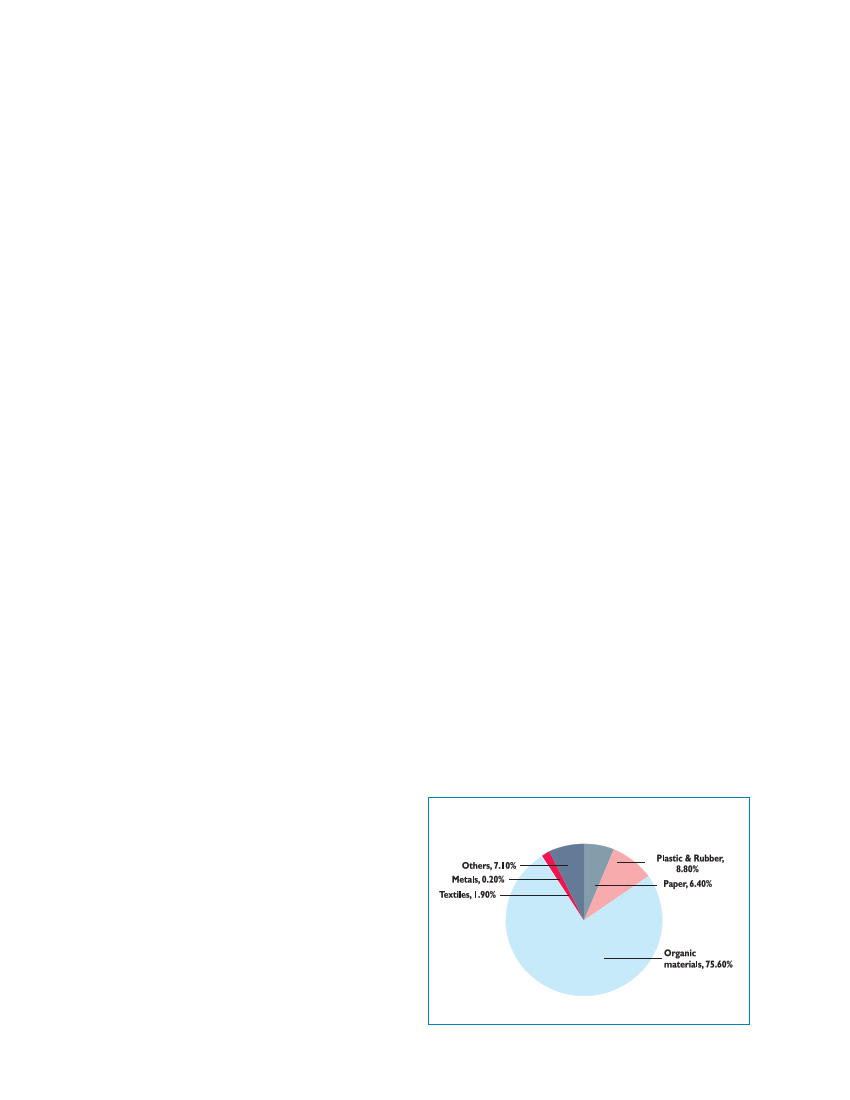
BEST PRACTICES ON SOLID WASTE MANAGEMENT OF NEPALESE CITIES
about the role of government in policy formulation
because, since 1998, local administration has been
conducted without elected representatives. This
situation has added to the problems of implementing
the Local Self Governance Act, 1999.
In this sub-metropolitan city, the Environment Section
has overall responsibility for waste management. The
main functions carried out by this section are, street
sweeping, roadside drain cleaning, removal of dead
animals, procurement and maintenance of waste
management vehicles, recruitment & training of waste
management staff, and public education, including
providing training to local residents. The contractor is
responsible for HH collection, transportion and dumping
of solid waste.
The main objectives of the waste management system
are to ensure effective collection, transport and sanitary
disposal of solid waste from HHs, businesses and
industrial areas.
Waste generation and composition
According to the most recent data provided by BSMC,
and the field survey conducted in May 2008, the average
HH waste generation rate is 0.33kg/person/day (BSMC,
2008 data), which is more than the national average of
0.25kg/capita/day and lower than the rate for
Kathmandu Valley, which is 0.39kg/capita/day
(SWMRMC, 2008 data).
The daily waste generation of Biratnagar Sub-
Metropolitan City is 55 tons/day (BSMC, 2008 data).
Approximate data indicates that 15 tons/day of waste
arise as a result of various business and commercial
activities, and the remaining 40 tons/day is HH waste
(BSMC, 2008 data). The composition of waste at source
was found to be paper 6.4 per cent, plastic and rubber
8.8 per cent, organic materials 75.6 per cent, metal 0.2
per cent, textiles 1.9 per cent, leather and other materials
7.1 per cent (BSMC, 2008 data).
The total number of hospital beds (in both government
and private establishments) in the city is 1,000 (BSMC,
2008 data). According to UN-HABITAT Nepal, the
generation rate for hospital waste in Nepal is 1.72 kg/
day/bed (UN-HABITAT, KMC data, 2007). Therefore, it is
estimated that the generation rate for healthcare waste
in BSMC is 1.8 tons/day.
Waste collection and recycling
Waste is collected from designated open collecting points
in almost 95 per cent of the urban area. The contractor
is responsible for the collection, transportion and
dumping of solid waste. Each morning, starting at
around 7.00 a.m., waste is collected door-to-door using
tricycles that can carry 300-500 kg. Previously, plastic
containers were used by the Silt Service Management,
but local people rejected these containers because of
the continuous bad odour that they omitted (because
waste was being deposited into them at any time of the
day and some of the waste was decomposing in the
containers for nearly 24 hours before the containers
were emptied). In order to encourage waste
minimisation and waste reduction at source, the
municipality is planning to launch HH composting and
the use of suiro hooks for recovering plastic. A
municipality source verified that waste management
in the industrial area is the responsibility of the
factories themselves.
One model compost plant with a capacity of 4 tons/day
of organic waste is operating in Ward no. 1 (BSMC,
2008 data). It is estimated that 30 per cent of both
domestic and commercial waste is recycled each day
(BSMC, 2008 data). The compost is sold for NRs.10 per
kg and plastic for NRs.6 per kg. The prices paid per kg
for other recovered materials are: metal NRs.35, paper
NRs.12, plastic NRs.6 and glass NRs.2 (BSMC, 2008
data). As BSMC is on the border with India, the recycling
business is flourishing.
Chart 4: Composition of Solid Waste generation
at source, Biratnagar Sub Metropolitan city
20